
By Alaa Magdy
The giant Microsoft, recently acquired Linkedin, as one of its latest acquisitions, however, the company has a history of its acquisitions fallout. Microsoft’s acquisition of Nokia has proved a failed experiment in the mobile phone industry.
The company has wasted at least $8 bn on its failed Nokia experiment, including the costs of restructuring and severance payments for thousands of employees. Microsoft originally hired 25,000 Nokia employees as part of its $7.2bn acquisition of Nokia’s phone business, but a series of layoffs over the past two years has triggered the end of Microsoft’s mobile subsidiary.
Microsoft’s acquisition of Nokia was surprising because Nokia was almost collapsing. Microsoft could have started its own mobile phone business. Many will argue Microsoft had no choice, as Nokia controlled more than 90 per cent of the Windows Phone market and had been rumored to be considering switching to Android. Nokia was the sole leader of their Windows Mobile Operation system. However, Nokia was not performing too well in the sales department. Also the quality of the products they were developing wasn’t up to the mark when compared to the huge smartphone market. So Microsoft could have acquired the non-financially stable Nokia to develop their phones on their own to increase their market share.
Microsoft’s vision of the future turned wrong. Microsoft’s CEO Satya Nadella recently stated: “We felt that a personal computer is the future of technology/internet but I guess we are wrong. We didn’t expect that smartphones will have such a huge impact.” It might have been Microsoft’s focus on computer software, the reason behind its collapsing mobile phone services. Windows Mobile Operating System was not given the priority to be developed properly. Therefore, it could not compete with the huge market of smartphones.
Ben Thompson of Stratechary, an analyst, commented on Microsoft’s acquisition of Nokia: “I have argued that Stephen Elop made a massive strategic error by choosing Windows Phone over Android; coming from Microsoft, he failed to appreciate that Nokia’s differentiation lay not in software, but in everything else in the value chain. It would have been to Nokia’s benefit to have everyone running Android, including themselves. Everyone would have the same OS(operating system), the same apps, may the best industrial design, distribution, and supply chain win. Today no one cares about Nokia’s industrial design, distribution, or supply chain, because their devices lack an app ecosystem, the price of entry into smartphones. Perhaps even now, Nokia was considering going to Android, or maybe even going out of business”.
In addition to Microsoft’s acquisition of Nokia to compete with Android in the mobile phone industry, Microsoft had bought one of the first Web-based e-mail providers, privately held Hotmail in 1998 for a rumored price between $400 and $500m. Microsoft admits that it’s basically a break-even business that is used to drive traffic to more strategic products like Bing and Office 365. However, Hotmail was well-known and widely used by over than 9 million users. It is hard to believe how Hotmail collapsed and finally shifted to Outlook. Hotmail could have been a much more successful business than just a break-even business. Was it another failure?
Similarly, Microsoft bought danger for a rumored price of $500m in early 2008 to help boost its mobile strategy. But the acquisition was botched by internal infighting, while the Danger team was put to work on what eventually became the Kin phone; a separate group was building Windows Phone 7. The Kin launched late and with fewer features than specified, and was cancelled less than two months later.
On the other hand, Microsoft is still a leading company in the software industry. Its launch of Windows 8 and Windows 10 gives it more credit in this industry. The latest version of Microsoft Corp’s Windows operating system has 270 million active users eight months after launch.











